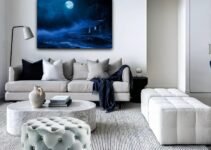Explore the benefits and trends of modular seating in modern living rooms. Discover how this versatile furniture type enhances adaptability, comfort, and aesthetics while reflecting personal style. Learn practical tips for integrating modular designs into your space, along with case studies and DIY options to create your own unique seating. Stay informed on the latest insights from industry experts on how modular seating can transform your home while promoting sustainability and functionality.
Introduction to Modular Seating
Modular seating has emerged as a leading trend in contemporary interior design, particularly within the context of modern living rooms. At its core, modular seating refers to furniture systems made up of individual pieces or units that can be easily rearranged and customized according to the user’s preferences and spatial requirements. This flexibility makes modular seating a practical solution for various living room layouts, accommodating both small, cozy spaces and larger, open-concept designs.

One of the primary attractions of modular seating is its inherent adaptability. Homeowners can mix and match different components, creating unique seating arrangements that suit their specific needs. For instance, a sectional sofa can be transformed into separate chairs or ottomans, allowing homeowners to optimize their living area for entertaining guests or simply relaxing with family. Moreover, modular seating items are frequently designed to be multifunctional, incorporating storage options or convertible features that further enhance their utility.
Please read our article watch the newly uploaded video from our YouTube channel:
“Grig Stamate – Interior Design Solutions”
https://www.youtube.com/@GrigStamate
TIMELESS DESIGN IDEAS | 70 Modern Living Rooms with Modular Seating (video)
Here, you can see other related videos from our channel:
30 TRANSITIONAL STYLE Living Room Ideas for a Timeless Look (video)
TIMELESS DESIGN IDEAS | Chic Living Rooms with Vibrant Accent Chairs (video)
The growing popularity of modular seating in modern living rooms can also be attributed to the emphasis on personalization in home interiors. As individuals seek to reflect their personal style, modular seating offers a canvas for creativity, allowing them to select from various styles, colors, and materials that complement their overall décor. Additionally, this type of furniture aligns well with the minimalist ethos that many contemporary homeowners embrace, promoting a clean, uncluttered aesthetic while maintaining comfort and functionality.
In this episode of our video series, we will delve deeper into the world of modular seating, exploring innovative designs and practical tips to help elevate your living room space. By examining the vast potential of modular seating, viewers will gain insight into how to enhance both the style and usability of their living areas, thus making the most of this versatile furniture solution.

Benefits of Modular Seating in Modern Living Rooms
Modular seating arrangements have increasingly become a popular choice in contemporary interior design, particularly in modern living rooms. One of the most significant advantages of modular seating is its adaptability to various spatial configurations. With homes varying in layout and size, modular pieces can be rearranged to fit different spaces, allowing homeowners to maximize the utility of their living areas. This flexibility ensures that even small living rooms can be designed to feel open and inviting.
Another essential benefit of modular seating is the ease of rearrangement. Unlike traditional seating furniture, modular units can be easily moved and reconfigured to create different seating arrangements. Whether it’s a cozy gathering for a movie night or a larger assembly for entertaining guests, these versatile options allow users to adapt the layout according to their needs. This dynamic approach not only promotes functionality but also contributes to the overall flow of the room.
Comfort is another key attribute of modular seating. Many contemporary designs focus on ergonomics, combining stylish aesthetics with functional comfort. Modular sofas can often be customized with various cushions and fabrics, providing the opportunity for homeowners to create a personalized experience that suits their preferences while ensuring the right support for relaxation.
Aesthetically, modular seating greatly enhances the visual appeal of modern living rooms. With clean lines and contemporary finishes, these arrangements contribute to the sleek and uncluttered looks that characterize current design trends. Moreover, the ability to mix and match colors and textures allows for creativity, enabling homeowners to make bold design statements or harmonize with existing decor.
In conclusion, the benefits of modular seating in modern living rooms are multifaceted, encompassing adaptability, ease of rearrangement, comfort, and aesthetic appeal. These qualities collectively enhance the living space, making it more functional and visually appealing while reflecting the nuances of contemporary design.
Key Trends in Modular Seating Designs
Modular seating has steadily gained popularity in contemporary interior design, reflecting the dynamic changes in lifestyle and living spaces. One of the key trends in modular seating is the emphasis on versatility and adaptability. Modern consumers seek furniture that can easily transform to suit varied needs, allowing spaces to serve multiple purposes. This integration of practicality ensures that a single seating arrangement can accommodate gatherings, relaxation, or even home offices.
The aesthetic appeal of modular seating significantly contributes to its rising trend. Popular styles currently characterizing the market include sleek, minimalist designs that emphasize clean lines and uncluttered forms. These designs often feature a low profile that enhances the feeling of openness in living rooms. Additionally, furniture pieces are increasingly available in rounded shapes, providing a more inviting atmosphere. This trend caters to a wide range of tastes, from contemporary and sophisticated to casual and cozy, making it easy to find options that fit seamlessly within various home decors.
Color choice is another vital aspect of modern modular seating trends. Neutral palettes dominate, with shades like beige, gray, and soft pastels enhancing the versatility and appeal of these designs. However, bolder colors are also making a statement, enabling individuals to express their personalities through vibrant hues that act as focal points in their living spaces. Furthermore, the choice of materials has evolved, with eco-friendly textiles gaining popularity, reflecting a broader societal movement towards sustainability.
In terms of configuration, modular seating allows for customized arrangements. Homeowners can create their ideal layouts, whether they prefer traditional L-shapes, U-shapes, or more fluid and organic configurations. This flexibility helps in achieving the desired flow of space while ensuring comfort. Overall, these trends highlight how modular seating aligns the functionality and aesthetics of modern living rooms, ultimately enhancing the design and experience of the home.
Incorporating Modular Seating into Your Living Room
Integrating modular seating into your living room can dramatically enhance both functionality and aesthetics, transforming your space into a versatile and inviting area. The first step in this process is to measure your available space accurately. This ensures that the modular pieces you choose will fit well without overwhelming the room. Be sure to consider not only the dimensions of the seating but also any existing furniture, windows, and doorways that could restrict movement or alter the flow of the space.
Next, it is crucial to understand the traffic flow within your living room. Modular seating offers flexibility, allowing you to arrange and rearrange the seating to accommodate various activities such as entertaining guests or cozy family nights. As you place the modular units, keep a clear path for foot traffic. Ideally, leaving at least 18 inches of walking space between furniture pieces will allow easy movement throughout the room. Additionally, consider how your seating arrangement will facilitate conversation and interactions among guests.
Choosing complementary decor is vital in achieving a cohesive look in your living room. The modular units should harmonize with the existing color palette, textures, and other furnishings. For instance, if your walls are painted in soft pastels, opt for modular seating in complementary shades or neutral tones that pull the entire design together. Accessories such as cushions, throws, and rugs can help blend the modular seating with the rest of the decor while adding a splash of personality to the space. Finally, don’t shy away from experimenting with different layouts to discover the best configuration that not only meets your needs but also highlights the beauty of modular designs.
Case Studies of Successful Modular Living Room Designs
Modern living rooms have increasingly embraced modular seating as a means to create dynamic and flexible spaces. This section explores several case studies that highlight successful implementations of modular designs, showcasing how these adaptable seating arrangements respond to various lifestyle needs and aesthetic preferences.
The first case study involves a compact urban apartment in New York City, where an open-concept layout maximizes the limited space. The design incorporates a modular sectional sofa that can be reconfigured, enabling residents to easily transition from entertaining guests to a cozy family movie night. The color scheme features neutral tones with accent pillows in vibrant hues, which not only adds visual interest but also promotes a cheerful atmosphere. By utilizing a modular coffee table that expands and contracts, the residents can modify the layout based on their activities, demonstrating the flexibility that modular seating offers.
In another case, a family home in the suburbs showcases a living room designed around modular ottomans and individual chairs. With a contemporary aesthetic, the seating arrangement encourages social interaction while providing ample space for movement. The choice of soft textiles in earthy colors fosters a warm, inviting environment, while strategically placed rugs define different functional areas within the space. This design illustrates how modular furniture can adapt to both intimate gatherings and larger celebrations, proving its practicality for diverse lifestyles.
Additonally, a third case presents a stylish coastal retreat where the modular design harmonizes with the surrounding environment. Here, the modular seating features weather-resistant materials, allowing it to be used both indoors and outdoors. The use of light, airy colors mirrors the ocean scenery, creating a cohesive look that enhances the overall experience of the living space. This case exemplifies how modular furniture can not only serve functional purposes but also enhance the connection between the interior and exterior spaces.
These case studies reflect diverse approaches to modular seating in modern living rooms, underscoring the versatility and adaptability of such designs in meeting varying lifestyle demands while maintaining a cohesive aesthetic. Through careful selection of materials, colors, and layouts, these living spaces showcase how modular concepts can transform home environments.
DIY Modular Seating Options
Creating your own modular seating is a rewarding and budget-friendly approach to enhancing your living space. With a few simple materials and some creativity, you can design comfortable, customizable seating that suits your personal style and meets your functional needs. Modular seating options can be tailored to any room size or shape, making them a practical solution for modern living rooms.
One popular method is to use plywood sheets and foam cushions to craft individual seating units. Start by cutting the plywood into desired shapes and sizes; square or rectangular units work well. Once the wooden frames are ready, add cushioning on top. You can use high-density foam for comfort and layer it with a soft fabric cover to create a chic look. Consider using a removable cover for ease of cleaning, allowing for versatility in style and design. Different colors and patterns can be employed to match your existing decor.
An alternative option involves repurposing items like old pallets or crates. Stacking and securing these wooden structures can give you unique, rustic modular seating. They can be painted or stained to align with your home’s aesthetic. Additionally, this can be a great way to incorporate eco-friendly practices into your design process.
For those looking to integrate functionality, consider building modular benches with storage. By hollowing out the frames and adding lift-top lids or drawers, you can create functional seating that also offers storage solutions for blankets, books, or other living room essentials. This dual function aligns perfectly with the principles of modern living, where space optimization is crucial.
Through these DIY modular seating options, you can foster creativity while crafting functional furniture that enhances your living room. Tailored to your specifications, this approach not only provides practical seating but also allows personal expression through design.
Maintenance and Care for Modular Seating
Modular seating has gained popularity for its versatility and design appeal, but proper care and maintenance are essential to ensure its longevity. Different materials such as fabric, leather, and synthetic blends require specific cleaning techniques to maintain their appearance and functionality. Understanding the characteristics of each material is crucial in determining the appropriate cleaning agents and methods to use.
For fabric modular seating, regular vacuuming is imperative to remove dust and debris from the surfaces as well as to prevent the accumulation of allergens. It is advisable to use a vacuum attachment designed for fabrics to avoid damaging the texture. For stains, it is best to address them promptly with a specialized fabric cleaner. Always follow the manufacturer’s guidelines when it comes to cleaning agents to ensure that the integrity of the fabric is preserved.
Leather modular seating is another popular choice and requires its own maintenance regime. Routinely wipe down leather surfaces with a damp cloth to remove dirt and perspiration. Moreover, using a leather conditioner periodically can help maintain its sheen and prevent it from drying out or cracking. Avoid exposing leather seating to direct sunlight, as excessive heat can fade its color and texture.
For modular seating made from synthetic materials, cleaning can often be simpler. Typically, these materials are designed to withstand spills and stains. Use a mild detergent mixed with water to gently clean the surfaces. Rinsing with a damp cloth afterwards ensures no residue remains. Regardless of the material, consistent care will enhance the durability and lifespan of modular seating.
In conclusion, understanding and implementing the best maintenance practices for modular seating is vital for longevity and aesthetics. By staying informed about the different material requirements and utilizing effective cleaning techniques, homeowners can ensure their investment remains functional and visually appealing for years to come.
Expert Insights on Modular Seating Trends
As the landscape of interior design continues to evolve, modular seating has emerged as a pivotal element in modern living rooms. Leading designers and industry professionals are gravitating towards this versatile option, appreciating its myriad benefits. Not only does modular seating offer flexibility in arrangement, but it also reflects an inclination towards personalized living spaces that cater to individual lifestyles. To glean expert insights on these emerging trends, we interviewed several prominent figures in the design community.
According to renowned interior designer Claire Thomas, “Modular seating reflects a shift towards multifunctional spaces. In urban living, where space is often at a premium, the ability to reconfigure furniture allows residents to adapt their environments to various needs, whether for relaxation, entertaining guests, or even working from home.” This sentiment is echoed by architect Mark Lee, who emphasizes that “the future of modular seating lies in its adaptability and sustainability. With a growing concern for the environment, manufacturers are increasingly using eco-friendly materials that are durable and visually appealing.”
Trend forecaster and design consultant Sarah Liu notes that the aesthetics of modular seating are also evolving. “We are witnessing a fusion of styles—traditional and contemporary elements are merging in unexpected ways, leading to striking designs that can be tailored to any decor.” She emphasizes the importance of color and texture, stating, “Vibrant hues and mixed materials are critical in creating dynamic focal points in living spaces, and modular furniture is instrumental in achieving that.” As these trends converge, they indicate that the future of modular seating will focus on both form and function, embodying the principles of modern design while offering comfort and practicality for everyday use.
Conclusion and Future Episodes Teaser
The exploration of modern living rooms featuring modular seating has illuminated its pivotal role in contemporary design. Modular seating arrangements offer versatility and adaptability, allowing homeowners to customize their living spaces according to their specific needs and preferences. This flexibility is not only practical but also contributes to a more dynamic and aesthetically pleasing environment. Additionally, the ability to rearrange or reconfigure furniture facilitates a more engaging interplay between form and function, enhancing the overall experience of the living room.
As we have seen, modular seating options provide a broad range of styles, colors, and materials, enabling individuals to express their personal tastes while maintaining a cohesive design narrative. Furthermore, this approach aligns with the principles of sustainability by allowing longer-term use and adaptation of the same pieces, thus minimizing waste and the need for constant replacements. The significance of implementing such designs cannot be overstated; they serve to create welcoming spaces that foster interaction, comfort, and cohesion among family members and guests alike.
Looking ahead, our ‘Timeless Design Ideas’ series will continue to delve into various aspects of interior design, focusing on themes that resonate with both classic and modern sensibilities. Future episodes will highlight innovative space-saving solutions, explore color psychology in design, and feature interviews with leading designers in the industry. We invite our viewers to stay tuned for these exciting installments, as we unlock more strategies and ideas to transform everyday spaces into remarkable environments. Your journey towards creating the perfect living room experience is just beginning, and we are here to guide you every step of the way.
Other related posts from our website:
Let’s see here, three of them:
https://howtobuildahouseblog.com/timeless-design-ideas-chic-living-rooms-with-accent-chairs/
https://howtobuildahouseblog.com/transitional-style-design-ideas-for-a-timeless-look/
https://howtobuildahouseblog.com/timeless-antique-living-room-design-ideas/
We also sincerely hope you like our ideas from this post, and you have also enjoyed our uploaded YouTube video.
See you next time at another article.
Thank you so much for your time. Bye now!


